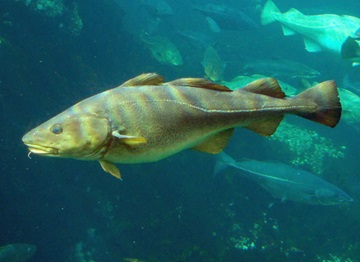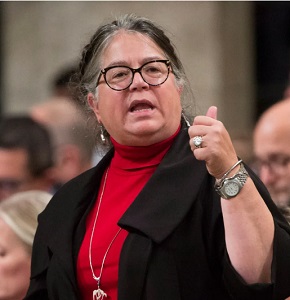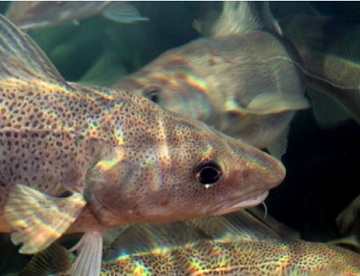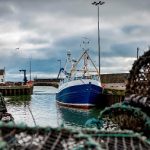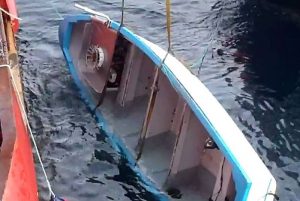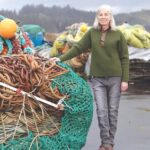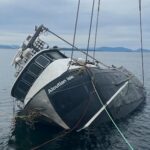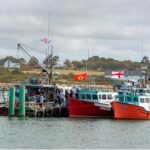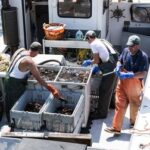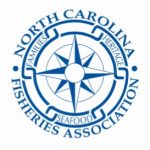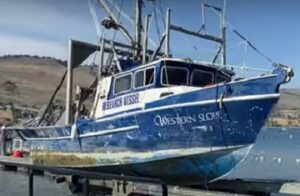Tag Archives: Northern cod
Federal court denies FFAW request for injunction against reopening of northern cod fishery
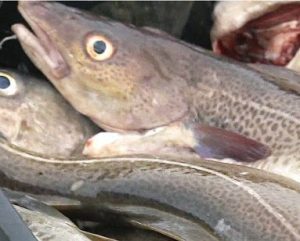 Federal court denies FFAW request for injunction against reopening of northern cod fishery. In July 2024, the FFAW requested a judicial review of the federal fisheries departments’ decision to reopen the northern cod fishery with a total allowable catch of 18,000 tonnes. Later, the FFAW requested an injunction against federal Fisheries Minister Diane Lebouthillier’s decision, made in June, to allocate 18,000 tonnes of cod for Canadian harvesters, and 1,080 tonnes for the offshore sector. Yesterday, the court denied the request for an injunction, stating that FFAW failed to demonstrate that irreparable harm. more, >>CLICK TO READ<< 11:25
Federal court denies FFAW request for injunction against reopening of northern cod fishery. In July 2024, the FFAW requested a judicial review of the federal fisheries departments’ decision to reopen the northern cod fishery with a total allowable catch of 18,000 tonnes. Later, the FFAW requested an injunction against federal Fisheries Minister Diane Lebouthillier’s decision, made in June, to allocate 18,000 tonnes of cod for Canadian harvesters, and 1,080 tonnes for the offshore sector. Yesterday, the court denied the request for an injunction, stating that FFAW failed to demonstrate that irreparable harm. more, >>CLICK TO READ<< 11:25
NAFO Annual Meeting 2024: Key Decisions on Cod and Redfish Stocks
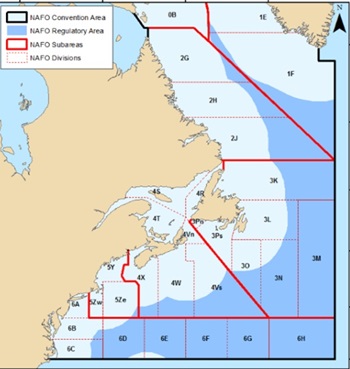 A joint proposal from the EU and Canada led to the reopening of the fishery for Northern cod in Divisions 2J, 3K, and 3L, with a revised sharing arrangement. This update was necessary, as the previous provisions had been in place since 1991. The EU’s share was increased to reflect its current composition, ensuring a fairer allocation of fishing rights. Additionally, fishing opportunities for 3M cod were increased, with existing technical measures maintained to protect the stock. NAFO’s decision rewards the fishing sector’s conservation efforts by increasing opportunities while maintaining caution to safeguard stock sustainability. A joint proposal from the EU and Canada led to the reopening of the fishery for Northern cod in Divisions 2J, 3K, and 3L, with a revised sharing arrangement. more, >>CLICK TO READ<< 08:03
A joint proposal from the EU and Canada led to the reopening of the fishery for Northern cod in Divisions 2J, 3K, and 3L, with a revised sharing arrangement. This update was necessary, as the previous provisions had been in place since 1991. The EU’s share was increased to reflect its current composition, ensuring a fairer allocation of fishing rights. Additionally, fishing opportunities for 3M cod were increased, with existing technical measures maintained to protect the stock. NAFO’s decision rewards the fishing sector’s conservation efforts by increasing opportunities while maintaining caution to safeguard stock sustainability. A joint proposal from the EU and Canada led to the reopening of the fishery for Northern cod in Divisions 2J, 3K, and 3L, with a revised sharing arrangement. more, >>CLICK TO READ<< 08:03
Federal Fisheries Minister Chose to Re-Open Northern Cod Commercial Fishery Against Recommendation for Stewardship Fishery
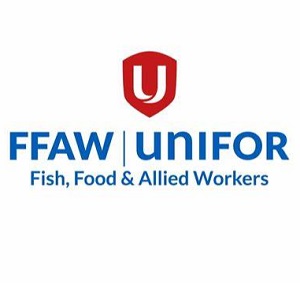 The Union representing fish harvesters in Newfoundland and Labrador have received more documents submitted by the Government of Canada in connection with the federal injunction filed by FFAW-Unifor in July, proving Minister Lebouthillier’s blatant negligence in ending the moratorium on Northern cod. These recent documents show that, despite insistence from NL Liberal MPs and DFO officials, Minister Diane Lebouthillier was presented with three options to decide a management approach for Northern cod in the 2024 season. In a document issued by the office of Deputy Minister Annette Gibbons on May 6, 2024, the recommended option from DFO bureaucrats and scientists was to maintain a stewardship fishery and maximum allowable harvest (MAH) level of 13,000t, reflecting a more cautious approach that would potentially result in less dramatic stock declines in the future and could help to avoid challenges in the management of the stock in the longer term. more, >>CLICK TO READ<< 08:57
The Union representing fish harvesters in Newfoundland and Labrador have received more documents submitted by the Government of Canada in connection with the federal injunction filed by FFAW-Unifor in July, proving Minister Lebouthillier’s blatant negligence in ending the moratorium on Northern cod. These recent documents show that, despite insistence from NL Liberal MPs and DFO officials, Minister Diane Lebouthillier was presented with three options to decide a management approach for Northern cod in the 2024 season. In a document issued by the office of Deputy Minister Annette Gibbons on May 6, 2024, the recommended option from DFO bureaucrats and scientists was to maintain a stewardship fishery and maximum allowable harvest (MAH) level of 13,000t, reflecting a more cautious approach that would potentially result in less dramatic stock declines in the future and could help to avoid challenges in the management of the stock in the longer term. more, >>CLICK TO READ<< 08:57Animal Protection Party of Canada calls for the resignation of Canada’s Fisheries Minister
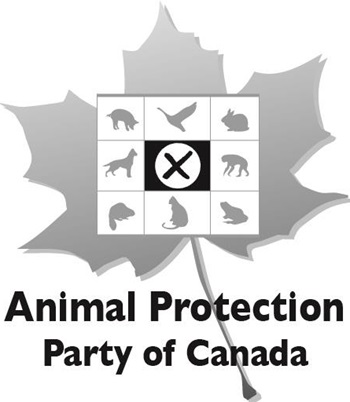 The Animal Protection Party of Canada calls for Prime Minister Trudeau to remove Diane Lebouthillier from her role as Fisheries Minister. “Canadians deserve ministers more committed to integrity and respect for science than political expediency,” says Party Leader, Liz White. White is reacting to a September 10th report by Radio-Canada’s Patrick Butler about a briefing note clearly explaining that staff with the Department of Fisheries recommended that the Minister keep the moratorium on northern cod in order to prevent a further decline in the population of fish. They also recommended that the current quota be maintained and not increased, and that she keep in place the ‘stewardship fishery’ meaning that fishing should be prioritized for inshore and Indigenous fishers and not for offshore and international fleets. more, >>CLICK TO READ<< 07:42
The Animal Protection Party of Canada calls for Prime Minister Trudeau to remove Diane Lebouthillier from her role as Fisheries Minister. “Canadians deserve ministers more committed to integrity and respect for science than political expediency,” says Party Leader, Liz White. White is reacting to a September 10th report by Radio-Canada’s Patrick Butler about a briefing note clearly explaining that staff with the Department of Fisheries recommended that the Minister keep the moratorium on northern cod in order to prevent a further decline in the population of fish. They also recommended that the current quota be maintained and not increased, and that she keep in place the ‘stewardship fishery’ meaning that fishing should be prioritized for inshore and Indigenous fishers and not for offshore and international fleets. more, >>CLICK TO READ<< 07:42
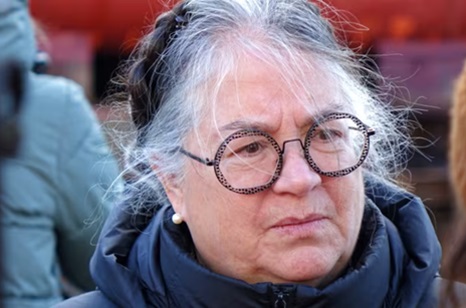
Federal Fisheries minister ignored DFO advice by reopening commercial cod fishery
Federal Fisheries Minister Diane Lebouthillier ignored the advice of staff within her department when she reopened the commercial cod fishery off Newfoundland and Labrador last June. A briefing note dated May 9 reveals that Fisheries and Oceans Canada recommended maintaining the long-time moratorium on northern cod based on scientific evidence, but that political advisors within the minister’s office argued reopening the commercial fishery and hiking quotas would be “politically a victory.” Senior policy advisor Paul Carrigan wrote that DFO staff were concerned about an increase to quotas and the return of offshore boats in the fishery, which would “increase the stocks’ risk of decline.” more, >>CLICK TO READ<< 06:47
FFAW Rotted with NL Liberal MPs’ Support for Return of Draggers
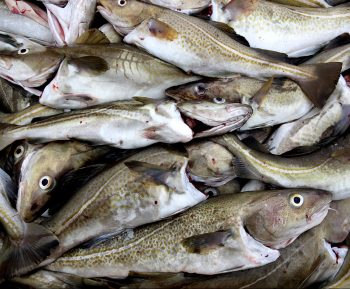 The FFAW says documents filed by Ottawa to defend reopening of a commercial cod fishery show all Liberal MPs supported the feds’ decision. The reopening once again gives local processors and NAFO countries access to the resource with offshore draggers, while the stock remains in the cautious zone. Pretty notes there was a promise for the first 115,000 metric tonnes of the 2J3KL northern cod quota to be allocated to inshore harvesters and Indigenous groups. He calls the actions of the six Liberal MPs — Gudie Hutchings, Seamus O’Regan, Joanne Thompson, Churence Rogers, Yvonne Jones, and Ken McDonald — “a total betrayal.” more, >>CLICK TO READ<< 07:01
The FFAW says documents filed by Ottawa to defend reopening of a commercial cod fishery show all Liberal MPs supported the feds’ decision. The reopening once again gives local processors and NAFO countries access to the resource with offshore draggers, while the stock remains in the cautious zone. Pretty notes there was a promise for the first 115,000 metric tonnes of the 2J3KL northern cod quota to be allocated to inshore harvesters and Indigenous groups. He calls the actions of the six Liberal MPs — Gudie Hutchings, Seamus O’Regan, Joanne Thompson, Churence Rogers, Yvonne Jones, and Ken McDonald — “a total betrayal.” more, >>CLICK TO READ<< 07:01
All NL MPs Supported Breaking Historical Agreement for Northern Cod, Injunction Documents Show
 Documents submitted by the Government of Canada as part of the federal injunction filed by FFAW-Unifor in July show that all Liberal MPs in the province supported breaking the longstanding agreement on Northern cod to allow offshore draggers access while the stock remains in the cautious zone. “Documents are quickly coming in from DFO staffers via the federal court process. What we’ve seen thus far is a Liberal caucus of NL politicians who supported breaking the 40-plus year agreement to our province – and while it’s certainly not shocking at this point, it should be a real eye opener to the people of our province who elected these individuals to office,” says FFAW-Unifor Greg Pretty. more, >>CLICK TO READ<< 09:30
Documents submitted by the Government of Canada as part of the federal injunction filed by FFAW-Unifor in July show that all Liberal MPs in the province supported breaking the longstanding agreement on Northern cod to allow offshore draggers access while the stock remains in the cautious zone. “Documents are quickly coming in from DFO staffers via the federal court process. What we’ve seen thus far is a Liberal caucus of NL politicians who supported breaking the 40-plus year agreement to our province – and while it’s certainly not shocking at this point, it should be a real eye opener to the people of our province who elected these individuals to office,” says FFAW-Unifor Greg Pretty. more, >>CLICK TO READ<< 09:30
NAFO Moving Forward with Offshore Dragger Access Despite Legal Injunction and Historical Agreement for Northern Cod
 Despite vocal opposition from industry and environmental groups, the North Atlantic Fisheries Organization (NAFO) is making strides towards allowing international and domestic offshore draggers back on the Northern cod grounds as early as this fall. The European Union (EU) is awaiting approval of their harvesting proposal from the NAFO Commission to get access to the fishery. “It is our strong opinion that the NAFO Commission should defer reopening the offshore allocation for the 2J3KL northern cod fishery. The reopening of the commercial cod fishery was done under poor faith by Minister Lebouthillier and Prime Minster Justin Trudeau; with both went against the advice of science, environment and industry, and also broke a four-decade commitment to our province,” says Pretty. “By lifting the 32-year moratorium on commercial fishing on June 26, 2024, the Government of Canada is further corporatizing public resources, limiting the economic sustainability of coastal communities, and breaking a decades long promise to the province of Newfoundland and Labrador,” Pretty explains. more, >>CLICK TO READ<<07:50
Despite vocal opposition from industry and environmental groups, the North Atlantic Fisheries Organization (NAFO) is making strides towards allowing international and domestic offshore draggers back on the Northern cod grounds as early as this fall. The European Union (EU) is awaiting approval of their harvesting proposal from the NAFO Commission to get access to the fishery. “It is our strong opinion that the NAFO Commission should defer reopening the offshore allocation for the 2J3KL northern cod fishery. The reopening of the commercial cod fishery was done under poor faith by Minister Lebouthillier and Prime Minster Justin Trudeau; with both went against the advice of science, environment and industry, and also broke a four-decade commitment to our province,” says Pretty. “By lifting the 32-year moratorium on commercial fishing on June 26, 2024, the Government of Canada is further corporatizing public resources, limiting the economic sustainability of coastal communities, and breaking a decades long promise to the province of Newfoundland and Labrador,” Pretty explains. more, >>CLICK TO READ<<07:50
The Newfoundland cod moratorium is over — but the risk remains
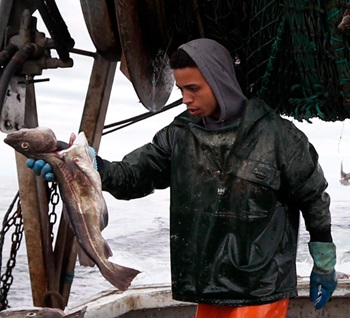 After more than 30 years, the federal government has announced it’s lifting the moratorium that shut down commercial cod fishing in Newfoundland and Labrador in the 1990s. The end of the moratorium includes a 46 per cent increase in total allowable catch from 13,000 tonnes in 2023 to 18,000 tonnes. Just before the collapse in the late 1980s, the total allowable catch was about 240,000 tonnes. Additionally, international offshore fisheries were allocated a quota of 1,000 tonnes, accounting for about five per cent of the total allowable catch. Reactions to the announcement have been mixed. Some organizations, like the Association of Seafood Producers, have voiced their support for the moratorium ending. Others are more skeptical. The union representing inshore fish harvesters, for instance, has asked the government to reverse the decision. more, >>CLICK TO READ<< 09:28
After more than 30 years, the federal government has announced it’s lifting the moratorium that shut down commercial cod fishing in Newfoundland and Labrador in the 1990s. The end of the moratorium includes a 46 per cent increase in total allowable catch from 13,000 tonnes in 2023 to 18,000 tonnes. Just before the collapse in the late 1980s, the total allowable catch was about 240,000 tonnes. Additionally, international offshore fisheries were allocated a quota of 1,000 tonnes, accounting for about five per cent of the total allowable catch. Reactions to the announcement have been mixed. Some organizations, like the Association of Seafood Producers, have voiced their support for the moratorium ending. Others are more skeptical. The union representing inshore fish harvesters, for instance, has asked the government to reverse the decision. more, >>CLICK TO READ<< 09:28
Free fish and smiley faces won’t reverse Ottawa decision to unleash draggers on northern cod (although blockading St. John’s harbour would)
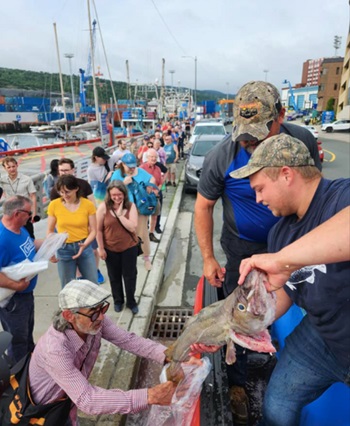 The FFAW regularly goes through protest motions, but its resolve to stand up for inshore boats is forever suspect when the union is conflicted by also representing offshore draggers, and onshore plants — and collects a paycheque from the feds. Now that Ottawa has opened the door to offshore dragging the inshore wants in on it too. Some Labrador (2J) harvesters have asked DFO to be allowed to drag for cod this year, and some 3K (northeast coast) and 3L (east coast) harvesters are right behind them with the same request. The union’s resolve against dragging for northern cod is sure to weaken. Exchanging cod for signatures won’t cut it. Blockading St. John’s harbour might be a bit extreme, but there should be a sweet spot somewhere the middle. Harvesters themselves must take a stand, like they did last spring with the snow crab price on the steps of Confederation Building. Now is the time for John Efford to rise again. more, >>CLICK TO READ<< 10:35
The FFAW regularly goes through protest motions, but its resolve to stand up for inshore boats is forever suspect when the union is conflicted by also representing offshore draggers, and onshore plants — and collects a paycheque from the feds. Now that Ottawa has opened the door to offshore dragging the inshore wants in on it too. Some Labrador (2J) harvesters have asked DFO to be allowed to drag for cod this year, and some 3K (northeast coast) and 3L (east coast) harvesters are right behind them with the same request. The union’s resolve against dragging for northern cod is sure to weaken. Exchanging cod for signatures won’t cut it. Blockading St. John’s harbour might be a bit extreme, but there should be a sweet spot somewhere the middle. Harvesters themselves must take a stand, like they did last spring with the snow crab price on the steps of Confederation Building. Now is the time for John Efford to rise again. more, >>CLICK TO READ<< 10:35
Letter to Prime Minister Trudeau and Minister Lebouthillier Re: Northern Cod
 Dear Prime Minister Trudeau and Minister Lebouthillier, We write today on a serious matter needing your attention. On behalf of 320,000 workers across the country, including more than 14,000 members of the Fish, Food and Allied Workers (FFAW) Union in Newfoundland and Labrador, we are calling on you to reverse a recent decision with respect to the northern cod moratorium. The decision to end the moratorium and grant access to corporate offshore interests flies in the face of what was committed by your government and decades of past fisheries management practice. We also are concerned with the impact this will have on a fishery that is still recovering. Your government must uphold its 2015 commitment to allocate the first 115,000 tonnes of northern cod quota to inshore harvesters and Indigenous groups and immediately reinstate the Northern cod stewardship fishery under the same conditions as 2023. more, >>CLICK TO READ<< 07:53
Dear Prime Minister Trudeau and Minister Lebouthillier, We write today on a serious matter needing your attention. On behalf of 320,000 workers across the country, including more than 14,000 members of the Fish, Food and Allied Workers (FFAW) Union in Newfoundland and Labrador, we are calling on you to reverse a recent decision with respect to the northern cod moratorium. The decision to end the moratorium and grant access to corporate offshore interests flies in the face of what was committed by your government and decades of past fisheries management practice. We also are concerned with the impact this will have on a fishery that is still recovering. Your government must uphold its 2015 commitment to allocate the first 115,000 tonnes of northern cod quota to inshore harvesters and Indigenous groups and immediately reinstate the Northern cod stewardship fishery under the same conditions as 2023. more, >>CLICK TO READ<< 07:53
Canada lifts 30-year cod fishing ban off Newfoundland and Labrador to mixed reactions
 The Canadian federal government has lifted the 30-year fishing ban for Northern cod off the north and east coasts of Newfoundland and Labrador – a “historic milestone” for the seafood industry in Canada’s Maritimes. This means that commercial fishing for Northern cod will resume in NAFO Divisions 2J3KL for the 2024 season. “We will cautiously but optimistically build back this fishery with the prime beneficiaries being coastal and Indigenous communities throughout Newfoundland and Labrador,” said the Honourable Diane Lebouthillier, Minister of Fisheries, Oceans and the Canadian Coast Guard in a press release. “As a government, we remain steadfast in our commitment to fostering sustainable and economically prosperous fisheries that honor our shared resources for generations to come. I encourage all participants to prioritize safety and enjoy a rewarding season on the water.” more, >>CLICK TO READ<< 09:51
The Canadian federal government has lifted the 30-year fishing ban for Northern cod off the north and east coasts of Newfoundland and Labrador – a “historic milestone” for the seafood industry in Canada’s Maritimes. This means that commercial fishing for Northern cod will resume in NAFO Divisions 2J3KL for the 2024 season. “We will cautiously but optimistically build back this fishery with the prime beneficiaries being coastal and Indigenous communities throughout Newfoundland and Labrador,” said the Honourable Diane Lebouthillier, Minister of Fisheries, Oceans and the Canadian Coast Guard in a press release. “As a government, we remain steadfast in our commitment to fostering sustainable and economically prosperous fisheries that honor our shared resources for generations to come. I encourage all participants to prioritize safety and enjoy a rewarding season on the water.” more, >>CLICK TO READ<< 09:51
DFO Rejects FFAW Working Group Proposal for Buddy Up in 2J3KL Northern Cod, Harvesters Forewarn of Offshore Draggers Coming
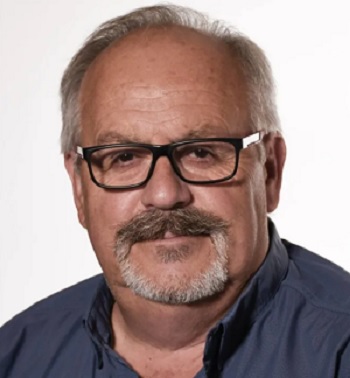 Despite an overwhelming majority voting in favour of buddy-up in cod, late yesterday afternoon DFO advised the FFAW that buddy-up will not be implemented in 2J3KL for the 2024 season. Harvesters fear that DFO is failing to manage the fishery in a way that supports the continued economic success of coastal communities in Newfoundland and Labrador and warn that the Department is threatening to allow offshore draggers access this fishing season. “Owner-operator fish harvesters who rely on the cod fishery have systematically and democratically worked over the last several months to find ways to improve our northern cod stewardship fishery, for the economic feasibility of the 2J3KL fleet,” says FFAW-Unifor Greg Pretty. “This fleet determined that the way to move forward was approving buddy-up but including important criteria that would ensure the fishery lasts more than a few days,” Pretty explains. “Moreover, harvesters are very fearful that the Liberal Government is positioning themselves to give away the northern cod resource to offshore draggers this fishing season,” Pretty says. more, >>CLICK TO READ<< 14:23
Despite an overwhelming majority voting in favour of buddy-up in cod, late yesterday afternoon DFO advised the FFAW that buddy-up will not be implemented in 2J3KL for the 2024 season. Harvesters fear that DFO is failing to manage the fishery in a way that supports the continued economic success of coastal communities in Newfoundland and Labrador and warn that the Department is threatening to allow offshore draggers access this fishing season. “Owner-operator fish harvesters who rely on the cod fishery have systematically and democratically worked over the last several months to find ways to improve our northern cod stewardship fishery, for the economic feasibility of the 2J3KL fleet,” says FFAW-Unifor Greg Pretty. “This fleet determined that the way to move forward was approving buddy-up but including important criteria that would ensure the fishery lasts more than a few days,” Pretty explains. “Moreover, harvesters are very fearful that the Liberal Government is positioning themselves to give away the northern cod resource to offshore draggers this fishing season,” Pretty says. more, >>CLICK TO READ<< 14:23
SEA-NL advises Ottawa to increase northern cod harvest, but not to lift ’92 moratorium
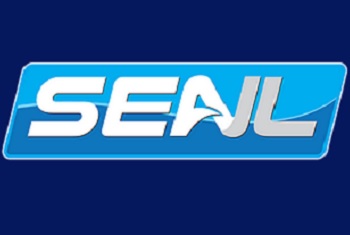 April 30th, 2024 – Seaward Enterprises Association of Newfoundland and Labrador (SEA-NL) has called on Ottawa to increase the 2024 northern cod harvest, but under a continued inshore stewardship fishery that bans offshore factory-freezer trawlers. “Lifting the moratorium and restarting a full-fledged commercial fishery for northern cod will open the gates to offshore draggers, foreign and domestic, which the stock is not ready for,” says SEA-NL President Bruce Layman, a Carbonear-based inshore fisherman. The debate on whether to lift the moratorium and restart a commercial fishery has picked up since last fall when DFO introduced a new assessment model that elevated the stock’s scientific status to “cautious” from the “critical” zone. more, >>CLICK TO READ<< 13:02
April 30th, 2024 – Seaward Enterprises Association of Newfoundland and Labrador (SEA-NL) has called on Ottawa to increase the 2024 northern cod harvest, but under a continued inshore stewardship fishery that bans offshore factory-freezer trawlers. “Lifting the moratorium and restarting a full-fledged commercial fishery for northern cod will open the gates to offshore draggers, foreign and domestic, which the stock is not ready for,” says SEA-NL President Bruce Layman, a Carbonear-based inshore fisherman. The debate on whether to lift the moratorium and restart a commercial fishery has picked up since last fall when DFO introduced a new assessment model that elevated the stock’s scientific status to “cautious” from the “critical” zone. more, >>CLICK TO READ<< 13:02
Northern cod remains in cautious zone, DFO says growth has stalled. FFAW critical of methodology
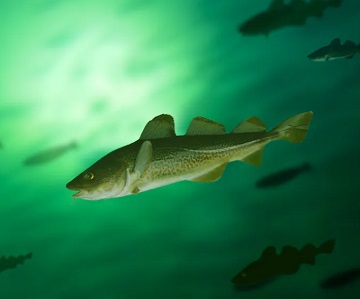 Scientists with the Department of Fisheries and Oceans Canada say the northern cod stock remains above the critical zone in Newfoundland and Labrador but hasn’t shown signs of growth since 2016. DFO released the findings of its latest stock assessment on Tuesday, showing levels are still in the cautious zone. Paul Regular, northern cod stock lead for DFO, said their findings suggest numbers haven’t changed much since 2016. The province’s fisheries union, meanwhile, is questioning the validity of DFO’s findings this year, given that some of the work was done earlier in the season than normal. Video, more, >>click to read<< 11:42
Scientists with the Department of Fisheries and Oceans Canada say the northern cod stock remains above the critical zone in Newfoundland and Labrador but hasn’t shown signs of growth since 2016. DFO released the findings of its latest stock assessment on Tuesday, showing levels are still in the cautious zone. Paul Regular, northern cod stock lead for DFO, said their findings suggest numbers haven’t changed much since 2016. The province’s fisheries union, meanwhile, is questioning the validity of DFO’s findings this year, given that some of the work was done earlier in the season than normal. Video, more, >>click to read<< 11:42
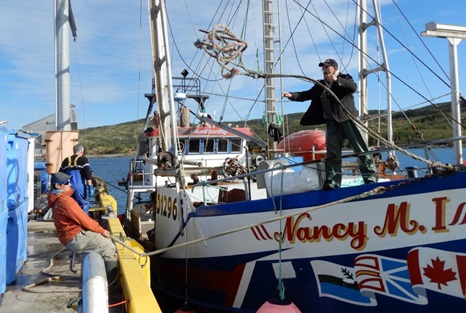
Northern cod numbers may have moved out of critical zone, says federal scientist
Captain Alex Saunders has more experience fishing northern cod than most fishermen. At 81 years old, the fishing captain has fished for cod off the Labrador coast for six decades. This year, he says, was a banner year for that fishery. “There were no codfish in northern Labrador for about 60 years, but this summer the cod were all along the Labrador coast from Blanc Sablan in the south to north of Nain,” Mr. Saunders says. A good catch rate this season meant Mr. Saunders’s crew hauled in 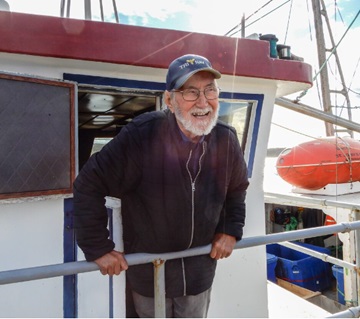 gillnets every day for weeks, returning to communities such as Pinsent’s Arm, a fishing town of about 50 people along the Labrador coast, to land cod at the wharf. But the season’s quick success also meant its early closing. “On a Friday afternoon they said, ‘Get your gear out of the water Sunday by six o’clock,’” Mr. Saunders says of the Department of Fisheries and Oceans’ (DFO) decision to shut down the fall northern cod stewardship fishery weeks earlier than planned – a measure to ensure fishing did not exceed season limits. Photos, >>click to read<< 08:33
gillnets every day for weeks, returning to communities such as Pinsent’s Arm, a fishing town of about 50 people along the Labrador coast, to land cod at the wharf. But the season’s quick success also meant its early closing. “On a Friday afternoon they said, ‘Get your gear out of the water Sunday by six o’clock,’” Mr. Saunders says of the Department of Fisheries and Oceans’ (DFO) decision to shut down the fall northern cod stewardship fishery weeks earlier than planned – a measure to ensure fishing did not exceed season limits. Photos, >>click to read<< 08:33
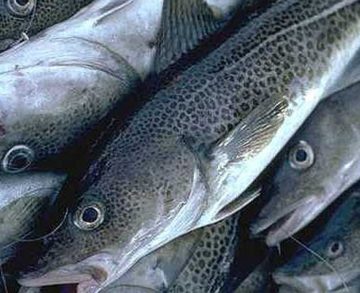
The NLGIDC are pleased with DFO’s revised assessment Model for Northern Cod
The Newfoundland and Labrador Groundfish Industry Development Council (NLGIDC) are pleased that The Department of Fisheries and Oceans (DFO) has implemented a revised model for assessing the 2J3KL cod stock. This model now utilizes data back to 1954 and shows that the 2J3KL cod stock is out of the critical zone and into the cautious zone of the Precautionary Approach (PA) Framework. In fact, the new model indicates the stock has been in the cautious zone since 2016. Previously the model only used data back to 1983. “The NLGIDC and other groups have been seeking changes to the stock assessment model for a number of years,” says Jim Baird, the Chair of the NLGIDC. >>click to read the Press Release<< 14:51
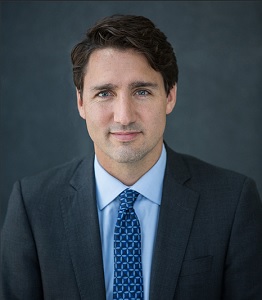
Trudeau Government Continues to Mismanage the Fishing Industry While Fish Harvesters and the Processing Industry Lose Opportunity
Conservative Shadow Minister for Fisheries, Oceans and the Canadian Coast Guard, Clifford Small, released the following statement after the Trudeau government refused to increase quotas for Northern Cod and the Atlantic Mackerel moratorium continues: “Trudeau’s Fisheries Minister, Joyce Murray, has once again ignored fishing industry stakeholders and harvesters by refusing to modestly increase fish quotas. A full survey assessment of fish stocks in Newfoundland has not been completed since 2019 and now because the Liberals failed to live up to their multiple promises to the industry, working people who make their living in the fishing industry will suffer. “The Trudeau government has failed to live up to its commitments on fisheries science and they are punishing working people without a second thought as a result. >click to continue< 16:42
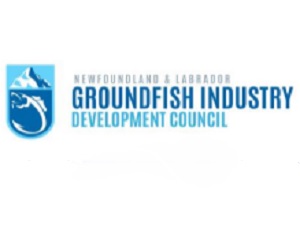
The Newfoundland and Labrador Groundfish Industry Development Council are Disappointed with the Northern Cod Maximum Allowable harvest announced today by DFO
“The NLGIDC were hoping for an increase in the harvest level for 2023 based on the extremely successful cod fishery in the 2J3KL area in 2022”, said James Baird, the chair of the NLGIDC. “Weekly harvest rates for the first 4 weeks of this fishery in 2022 all surpassed the highest weekly landings observed in this fishery since 2016”, continued Baird. “Additionally, the lack of science assessments for Northern cod in 2022 and 2023 continue to hinder the development of this iconic fishery and is a cause of considerable concern for the Newfoundland and Labrador fishing industry”, said Paul Grant, the Executive Vice-President of Beothic Fish Processors Ltd. >click to read< 18:48

DFO Rolls Over Cod Quota, Fails to Use All Available Data for Assessment
Today, the Department of Fisheries and Oceans (DFO) announced a rollover to the Maximum Allowable Harvest (MAH) for the 2J3KL Northern Cod Stewardship fishery. The rollover comes as a surprise to harvesters, who requested an increase this year in line with the health of the stock and commercial needs for both harvesting and processing. Harvesters consider Northern Cod to be one of the best fisheries for both quality and catch rates, and both harvesters and processors are looking for more product this year. >click to read< 17:25
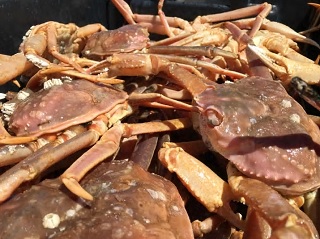
Opinion: Canada failed the N.L. fishery by Harvey Jarvis
The 2023 crash in the price of snow crab and the 1992 moratorium on northern cod have been talked about as the two major catastrophic events in the Newfoundland Labrador inshore fishery. While I totally agree that the two events have inflicted major damage on those who make a living from our ocean’s renewable resources, in my opinion, neither of them is THE major catastrophic event. In 1949, Newfoundland Labrador signed over control and management of the world’s richest renewable resources to Canada. While Canada was supposed to manage those resources to produce maximum benefit to Newfoundland Labrador, the opposite has occurred. >click to read< 13:17
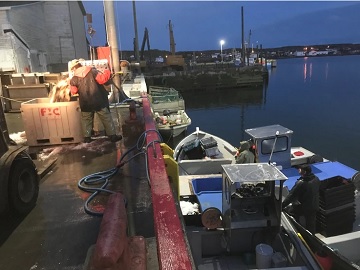
Northern cod 30 years after the moratorium: Confederation’s greatest shame
As the 30th anniversary of the northern cod moratorium looms, DFO cannot say with certainty whether the at-sea fall survey will be completed this year, the small-scale inshore fishery limps on with an average price of 64¢/lb, and the number of active enterprises has fallen to 1,259 — a shadow of the fishery’s glory days when the stock supported 30,000-40,000 workers. On the plus side, scientists with Fisheries and Oceans finally acknowledge that seals “undoubtedly” have an impact on cod — just not as huge as the lack of caplin (which seals also eat by the millions of pounds, but one DFO baby step at a time). >click to read< 08:02
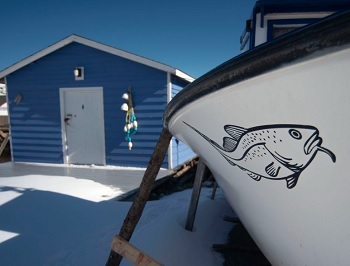
Nearly 30 years into the moratorium, Newfoundlanders look for ways to rebuild Cod
Atlantic cod, the species better known by its population name, Northern cod, is the fish of choice for Newfoundlanders and Labradorians. On a day spent handlining cod on the North Atlantic off of Petty Harbour-Maddox Cove, a centuries-old fishing community just outside of St. John’s, it can be easy to forget cod has a storied history – and a still uncertain future. Northern cod survived near-decimation from overfishing three decades ago, leading the federal department of Fisheries and Oceans Canada (DFO) to shutter the commercial cod fishery in 1992. Meant to last two years, the cod moratorium remains in effect, although DFO reopened an inshore commercial fishery, called the “stewardship fishery,” in 2006. >click to read< 11:00
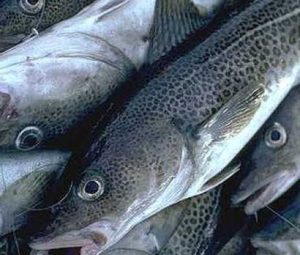
The flawed plan to rebuild Canada’s Northern cod – DFO’s plan is riddled with science and policy weaknesses
Canada is on the cusp of an inauspicious anniversary. Next year will mark 30 years since Newfoundland’s 500-year-old Northern cod fishery was shut down. The fishery was closed on July 2, 1992, because of a massive decline in the cod population, as much as 95 per cent, between the early 1960s and the early 1990s. The socioeconomic consequences were staggering: 30,000 to 40,000 jobs vanished overnight. Closure of what once was the largest cod fishery in the world stimulated an exodus of 10 per cent of the province’s population by the turn of the 21st century. Resource depletion was not anticipated when the federal Fisheries Act was passed in 1868. >click to read< 06:25
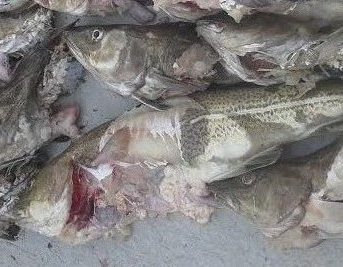
Northern cod growth off NL stalled, latest science indicates
Department of Fisheries and Oceans (DFO) on Friday released it’s latest stock status assessment information on northern cod. “We continue to be concerned about the status of the northern cod stock, which remains in the critical zone,” a technical briefing document states. “Survey indices suggest that recently observed stock growth (2012-2016) may have stalled. Ecosystem conditions indicated limited productivity and reduced food availability may be limiting growth of cod. “The precautionary approach requires that removals be kept at lowest possible levels.” >click to read< Does the precautionary approach include a plan for a major extraction of marine mammals? Asking for a friend. 11:32
Researchers tracking fish to learn more about where they migrate and spawn
Northern cod are about to experience a much higher level of surveillance. The iconic fish — 1,260 of them — are having small transmitters implanted into their bellies. As the cod swim about, their transmitters will send information to 75 acoustic receivers moored to the ocean floor in 13 areas along the eastern continental shelf and in three areas closer to shore in cod fishery area 2J3KL. >click to read< 19:10
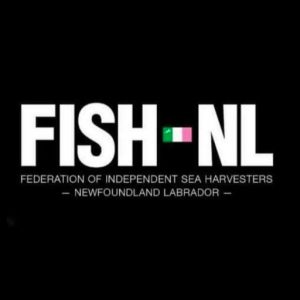
FISH-NL calls for immediate halt to all fishing for northern cod outside stewardship fishery; independent assessment of DFO science
“When one of the preeminent fisheries science researchers in the world warns that Fisheries and Oceans may be dramatically overestimating the size of the iconic northern cod stock — which is already classified as critical, and in the 27th year of a commercial fishing moratorium — you listen,” says Ryan Cleary, President of FISH-NL. “From FISH-NL’s perspective, we must also err on the side of caution and take immediate and unprecedented action,” said Cleary. “That means a cancellation of all fishing for northern cod outside of the stewardship fishery — including the sentinel (test) fisheries, cod quality program, recreation/food fishery, and any and all fishing of northern cod by offshore, factory-freezer trawlers, foreign or domestic.” >click to read< 09:02






